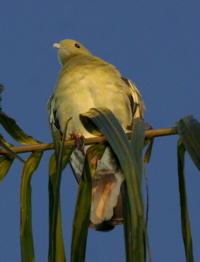Pink-necked Green Pigeons 1: The search for information
 I got involved in Pink-necked Green Pigeons (Treron vernans) when they started visiting my garden some years back. They loved to perch high up on the back of the fronds of my ceram palms (Rhopaloblaste ceramica) during mornings and evenings. They would make soft gurgling and bubbling sounds and I would be alerted to their presence. There were always a few pairs, first perching apart but gradually moving closer together, very much like shy courting couples on park benches.
I got involved in Pink-necked Green Pigeons (Treron vernans) when they started visiting my garden some years back. They loved to perch high up on the back of the fronds of my ceram palms (Rhopaloblaste ceramica) during mornings and evenings. They would make soft gurgling and bubbling sounds and I would be alerted to their presence. There were always a few pairs, first perching apart but gradually moving closer together, very much like shy courting couples on park benches. My interest really took off when a pair nested among the branches of my Dracaena reflexa “Song of India” tree in February 2005. This was the second time a pair had been nesting. The first occasion was a few years back. At that time I was watching the birds incubating the eggs. Whenever I looked at the nest the male would be there, sitting comfortably and never moving.
The constant presence of the male in the nest puzzled me. As I was then not really interested in birds but just wanting to capture images of them nesting, the puzzling thought did not remain for long. Until that fine morning when another pair nested in the same tree.
Again, it was always the male bird sitting quietly in the nest. Puzzled, I consulted my two favourite bird books: Madoc’s “An Introduction to Malayan Birds” and Hails’ “Birds of Singapore.” Only the flimsy nest and two white eggs were mentioned.
Desperate, I trawled the net. Google search yielded 814 hits for Pink-necked Green Pigeons. Prominent among the results was Ria Tan's webpage. It gave information that was already published. This was acceptable as she was not a bird watcher. The other 813 hits were generally irrelevant.
 David Wells’ 1999 book, “The Birds of the Thai-Malay Peninsula” stated that both birds helped incubate the eggs. But this did not help as I only saw the male in the nest. The female was not seen around at all.
David Wells’ 1999 book, “The Birds of the Thai-Malay Peninsula” stated that both birds helped incubate the eggs. But this did not help as I only saw the male in the nest. The female was not seen around at all.It was very much later when I acquired a copy of “The Selby Guide to Bird Life and Behaviour” by D.A. Sibley (2001) that I found out that the male pigeon incubates the eggs during the daylight hours and the female through the night. But then this was weeks after I discovered the fact through hours of tedious observations.
So the relevant information may be available in foreign publications, based on observations of foreign birds. Obviously, information on local birds are desperately lacking.
Labels: Nesting



4 Comments:
I once followed closely the growth of a clutch of eggs that was laid in the hedge surrounding my condo in Loyang Valley. I was after the chicks of other birds to keep as pets.....a childhood hobby that has left lots of fond memories of very loyal pets, when i stumbled on a tiny almost orange in colour chick of the pink necked green pigeon. Unfamiliar with the dietary requirements of these birds. I left them alone and watch them from a distance every day.
I have never seen this bird in captivity in singapore, but during a dive trip to one of the islands in malaysia, i saw the locals there keeping them as pets much in the same way as spotted necked dove are kept.
Jeremy
Deborah Lauri 14-Jan-2012 15:09
I have an amazing photo sent to me of this bird with 2 babies under it's wings. Can I send it to you for your page?
did you see what they eat?
Seeds and fruits mainly.
Post a Comment
<< Home